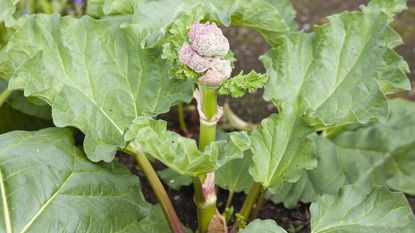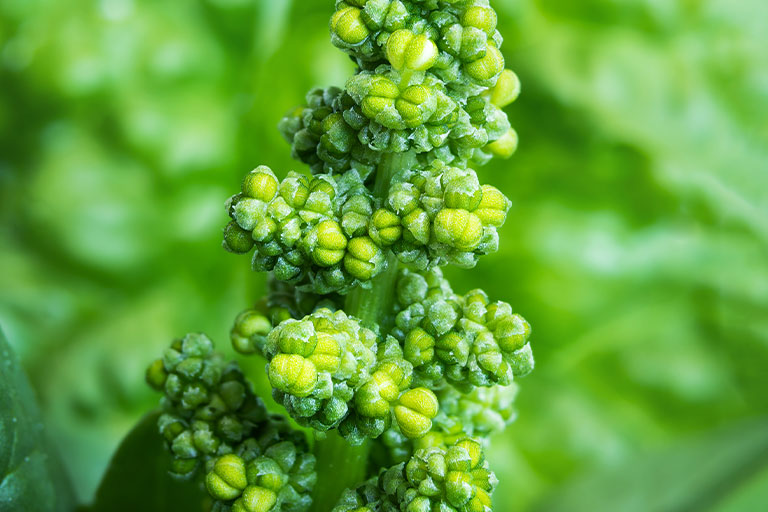To prevent plants from bolting, maintain consistent watering and provide adequate shade. Choose bolt-resistant varieties for better results.
Bolting occurs when plants prematurely produce seeds, often compromising the quality and flavor of your crops. This common issue arises due to stress factors like temperature fluctuations, inadequate watering, or nutrient imbalances. Gardeners can manage and prevent bolting by maintaining consistent watering schedules and providing shade during hot weather.
Selecting bolt-resistant varieties also helps in reducing the likelihood of bolting. Regularly monitoring soil conditions and using mulch can further stabilize the growing environment. Taking these steps ensures healthier plants and a more productive garden, keeping your crops from going to seed prematurely.
Bolting Basics
Understanding bolting is crucial for every gardener. Bolting happens when plants go to seed too early. This can affect the taste and yield of your crops. Let’s dive into the basics of bolting and how to prevent it.
What Is Bolting?
Bolting is when a plant starts to produce seeds prematurely. This process can make vegetables taste bitter. It often happens with leafy greens like lettuce, spinach, and herbs.
Common Causes
There are several common causes of bolting. Knowing these can help you prevent it.
| Cause | Description |
|---|---|
| Temperature | Warm temperatures can trigger bolting. Cool-season plants are most affected. |
| Day Length | Longer days in spring and summer can cause bolting. Plants sense the change in light. |
| Stress | Any stress, like drought or poor soil, can make plants bolt. Keep your plants healthy. |
Here are some tips to prevent bolting:
- Choose bolt-resistant varieties.
- Keep the soil moist and fertile.
- Plant at the right time of year.
- Provide shade during hot days.
Following these tips can help you enjoy a longer harvest. Happy gardening!

Credit: www.gardeningknowhow.com
Signs Of Bolting
Bolting is a common problem for gardeners. It happens when plants go to seed. Knowing the signs of bolting helps prevent it. Look for these signs early to save your plants.
Early Indicators
Temperature changes can trigger bolting. Warm days and cool nights confuse plants. Day length affects plants too. Longer days signal plants to bolt. Nutrient stress is another cause. Lack of nutrients forces plants to seed.
Watering issues also play a role. Too much or too little water stresses plants. Plant age matters as well. Older plants are more likely to bolt.
Visual Cues
Watch for tall flower stalks. These stalks grow quickly and are a clear sign. Leaves change shape and size. They become smaller and more bitter.
Flower buds may appear. These buds are tiny at first. They grow fast and become flowers. Yellowing leaves show nutrient stress. This often leads to bolting.
Below is a table of common visual cues:
| Visual Cue | Description |
|---|---|
| Tall Flower Stalks | Rapid growth of a central stalk |
| Change in Leaf Shape | Leaves become smaller and bitter |
| Flower Buds | Small buds that grow into flowers |
| Yellowing Leaves | Leaves turn yellow due to nutrient stress |
Preventing bolting starts with knowing these signs. Keep an eye on your plants. Act quickly to save your garden.
Impact On Plants
The phenomenon of bolting can significantly affect your plants. Understanding its impact helps prevent it and maintain healthy crops.
Reduced Yield
Bolting leads to reduced yield in your garden. Plants focus their energy on producing seeds, not leaves or fruits.
| Plant Type | Expected Yield | Yield After Bolting |
|---|---|---|
| Lettuce | 20 leaves per plant | 10 leaves per plant |
| Spinach | 30 leaves per plant | 15 leaves per plant |
Altered Flavor
Bolting changes the flavor of your vegetables. They develop a bitter taste, making them less enjoyable to eat.
- Lettuce: Becomes tough and bitter.
- Spinach: Leaves turn tough and less palatable.
- Radishes: Roots get woody and unappetizing.
Prevent bolting to keep your vegetables flavorful and tender.
Preventive Measures
Preventing your plants from going to seed, also known as bolting, is essential. Bolting can impact the quality of your harvest. Implementing preventive measures helps maintain a healthy garden. These measures include proper planting times and choosing the right plant varieties.
Optimal Planting Times
Planting at the right time can reduce the chances of bolting. Most plants bolt due to temperature changes. Here’s a table of optimal planting times for common vegetables:
| Vegetable | Optimal Planting Time |
|---|---|
| Lettuce | Early Spring or Late Summer |
| Spinach | Early Spring or Late Summer |
| Broccoli | Early Spring or Late Summer |
Planting during cooler times can help prevent bolting. Monitor your local weather for ideal planting periods. This helps ensure a longer growing season.
Choosing The Right Varieties
Some plant varieties are more resistant to bolting. Choosing these can help maintain a healthy garden. Here are some recommendations:
- Lettuce: Opt for varieties like ‘Butterhead’ or ‘Romaine’.
- Spinach: Choose ‘Bloomsdale’ or ‘New Zealand’ varieties.
- Broccoli: Select ‘Calabrese’ or ‘Arcadia’ types.
Researching and selecting the right varieties can significantly reduce bolting. This ensures a better yield and a healthier garden.
Watering Techniques
Effective watering techniques are essential to prevent your plants from bolting. Bolting occurs when plants go to seed prematurely, often due to environmental stress. Understanding how to manage watering can keep your garden healthy and productive. Let’s dive into some key techniques.
Consistent Moisture
Maintaining consistent moisture is crucial for plant health. Fluctuating moisture levels stress plants, causing them to bolt.
- Water your plants regularly.
- Use a soaker hose for even distribution.
- Mulch to retain soil moisture.
Inconsistent watering can lead to shallow roots. Shallow roots make plants more susceptible to stress and bolting.
Avoiding Stress
Minimizing stress is key to preventing bolting. Environmental stress triggers plants to go to seed.
- Water early in the morning.
- Avoid watering during the hottest part of the day.
- Ensure soil is well-draining.
Stress from heat and drought makes plants bolt. Keep your garden cool and hydrated.
Temperature Control
Temperature control is crucial for preventing plants from bolting. High temperatures often trigger plants to go to seed. This can ruin your harvest. Keeping your garden cool will help your plants thrive longer.
Shade Solutions
Providing shade can help keep your garden cool. Use shade cloths or garden nets. These materials block some sunlight but still allow air circulation. You can also plant tall crops to provide natural shade for shorter plants.
- Install shade cloths
- Use garden nets
- Plant tall crops for natural shade
Mulching Benefits
Mulching is another effective way to control temperature. It helps keep the soil cool by retaining moisture. Mulch also reduces the soil temperature fluctuations. Organic mulches like straw or wood chips are ideal. They also improve soil quality as they decompose.
| Mulch Type | Benefits |
|---|---|
| Straw | Retains moisture, cools soil |
| Wood Chips | Reduces temperature fluctuations, improves soil |
Soil Management
Proper soil management is crucial for preventing plants from bolting. Healthy soil keeps plants strong and helps them grow well. Two key aspects of soil management are nutrient balance and proper drainage. Let’s explore these in detail.
Nutrient Balance
A balanced supply of nutrients ensures plants stay healthy. Plants need a mix of nitrogen, phosphorus, and potassium. Too much or too little of these can cause stress, leading to bolting. Regularly test your soil to check nutrient levels. Use the table below to understand the nutrient needs:
| Nutrient | Function | Sources |
|---|---|---|
| Nitrogen (N) | Leaf growth | Compost, manure |
| Phosphorus (P) | Root development | Bone meal, rock phosphate |
| Potassium (K) | Overall plant health | Wood ash, kelp meal |
Keep a balance of these nutrients. Avoid over-fertilizing, as this can cause rapid growth and stress.
Proper Drainage
Good drainage prevents waterlogging, which stresses plants. Poor drainage can lead to root rot and other problems. Ensure your soil has good texture and structure. Here are some tips for improving drainage:
- Aerate the soil by adding organic matter.
- Use raised beds to improve water flow.
- Check soil compaction and break it up if needed.
These steps help roots get the oxygen they need. Well-drained soil keeps plants healthy and reduces the risk of bolting.

Credit: www.futuregarden.co.uk
Post-bolting Strategies
When your plants start to bolt, it can be disheartening. Bolting occurs when plants rapidly produce flowers and seeds. This often results in a loss of flavor or texture. But, don’t worry, there are effective strategies to manage this situation. Below are some methods to handle bolted plants and future prevention tips.
Handling Bolted Plants
Bolted plants can still be useful. Here are some steps to take:
- Remove Flower Stalks: Cut off the flower stalks as soon as they appear. This may slow down the process.
- Harvest Seeds: Collect seeds from bolted plants for future planting.
- Compost: Add bolted plants to your compost pile to enrich the soil.
- Use as Animal Feed: Some bolted plants can be fed to livestock.
Future Prevention Tips
Preventing bolting can save your plants. Follow these tips:
- Choose Bolt-Resistant Varieties: Select plant varieties known to resist bolting.
- Proper Timing: Plant crops at the right time to avoid stress.
- Water Consistently: Ensure plants get consistent water to reduce stress.
- Mulch: Use mulch to keep the soil cool and moist.
- Shade: Provide shade during hot weather to keep plants cool.
By following these strategies, you can manage and prevent bolting. This ensures a healthier and more productive garden.

Credit: plantura.garden
Frequently Asked Questions
Why Do Plants Bolt?
Plants bolt when they experience stress or extreme temperatures. This leads them to flower and produce seeds prematurely. Bolting is a survival mechanism.
How Can I Prevent Bolting?
Prevent bolting by maintaining consistent soil moisture and providing shade. Choose bolt-resistant varieties and avoid planting in extreme temperatures.
What Are The Signs Of Bolting?
Signs of bolting include elongated stems, rapid growth, and the appearance of flower buds. Leaves may become bitter.
Which Plants Are Prone To Bolting?
Leafy greens like lettuce, spinach, and herbs like cilantro and basil are prone to bolting. Root vegetables can also bolt.
Conclusion
Preventing your plants from bolting ensures a healthier garden. Implement proper watering, shading, and timely harvesting. Understand plant needs and monitor closely. These steps lead to thriving plants, yielding better produce. Stay vigilant, and your garden will thank you with bountiful harvests.
Happy gardening!


